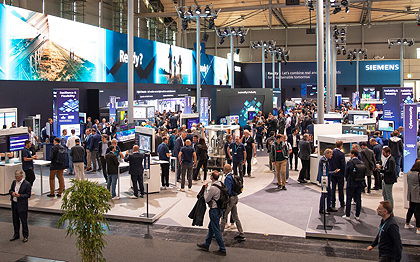Siemens and Microsoft revealed plans to harness the collaborative power of generative artificial intelligence (AI) to help drive innovation and efficiency across the design, engineering, manufacturing and operational lifecycle of products. The companies are integrating Siemens’ Teamcenter software for product lifecycle management (PLM) with Microsoft’s collaboration platform Teams and the language models in Azure OpenAI Service as well as other Azure AI capabilities.
Siemens and Microsoft are also collaborating to help automation engineers to generate, optimise and debug PLC code faster. At Hannover, they showed how OpenAI’s ChatGPT and other Azure AI services can augment automation engineering, helping engineers to save time and reduce the risk of errors by generating PLC code through natural language inputs. This can also help maintenance teams to identify errors and generate remedies faster.
The two companies were also demonstrating how generative AI can enhance factory operations through AI-powered software development, problem reporting and visual quality inspection.
They are using AI to detect production defects fast enough to prevent costly and time-consuming disruptions. At Hannover, they demonstrated Microsoft Azure Machine Learning being used with Siemens’ Industrial Edge to analyse machine images and to build, deploy, run and monitor AI vision models on the shop floor.
“The integration of AI into technology platforms will profoundly change how we work and how every business operates,” said Scott Guthrie, executive vice-president of Microsoft’s cloud and AI activities. “With Siemens, we are bringing the power of AI to more industrial organisations, enabling them to simplify workflows, overcome silos and collaborate in more inclusive ways to accelerate customer-centric innovation.”
“Powerful, advanced AI is emerging as one of the most important technologies for digital transformation,” added Cedrik Neike, CEO of Siemens Digital Industries. “Siemens and Microsoft are coming together to deploy tools like ChatGPT so we can empower workers at enterprises of all sizes to collaborate and innovate in new ways.”
Meanwhile, Siemens Digital Industries Software and IBM announced at the show that they are developing a combined software portfolio that integrates their offerings for systems engineering, service lifecycle management and asset management.
The companies will develop software to help organisations to optimise product lifecycles, and to make it easier to improve traceability across processes, to test concepts much earlier in development, and to adopt more sustainable product designs. The aim is to speed innovation and time-to-market, potentially leading to improved quality and lower costs.
“A significant portion of product innovation and differentiation contains electrical, electronics and software components,” said Dr Kareem Yusuf, senior vice-president of product management and growth at IBM Software. “Yet, manufacturing companies are struggling to bring new products to market on time, as the current tools, processes, and information to manage these components are siloed and disconnected.

Siemens used its large presence at Hannover to promote its collaboration with other players
“To address this gap,” he continued, “IBM and Siemens are collaborating on a digital thread environment to integrate sustainability practices throughout the lifecycle of a product, from design, production, operation, maintenance and beyond. This connectivity will help enable quicker time to innovation and compliance preparedness, and overall improved product quality.”
“Together, Siemens and IBM will deliver simulation-driven systems and software engineering designed to cover the full operational lifecycle,” added Tony Hemmelgarn, president and CEO of Siemens Digital Industries Software. “This can empower our customers to innovate by helping to reduce product development costs, drive continuous improvement and create operational efficiencies across the extended enterprise throughout the product’s operation lifecycle.
“We are developing this to help companies truly shift left by improving extensibility and reuse of systems models and associated data with standards-based solutions in an open ecosystem and to enable our customers to develop better products.”
Siemens: Twitter LinkedIn Facebook
Microsoft Azure: Twitter LinkedIn

